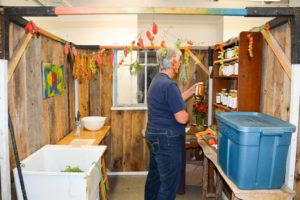MANITOWANING—Debajehmujig Storytellers annual 6 Foot Festival was once again held last week, this time with the theme of ‘Year of the Pig’ and which included, well, all things pig.
Following a water cooler conversation (in Debaj’s case, a chat under ‘the big tree’) about how every part of the pig can be used for something, the crew decided to take that challenge and make it their own, turning 2016 into the Year of the Pig.
“One of the foundation teachings that can be seen at the Peterborough Petroglyph site is the ‘four axes’—the symbols carved in the rock,” Year of the Pig lead Ashley Manitowabi explains.
“Living in Wikwemikong, everybody knows how to cook Indian corn soup, or knows somebody that can,” he continues. “There are a lot of people that have corn soup for dinner made with pork hocks or salt pork. And as a people, we have deep knowledge of many animals and birds and fish, but what do we know about a pig?”
And so it began, the Storytellers applied themselves to learning about the pig and making it a part of everything.
The troupe first approached the elders of Wikwemikong for knowledge on pigs, but were left wanting more, especially concerning the raising of pigs. If they were going to do it, they were going to practice the best animal husbandry practices they could.
In the fall of 2015, Debajehmujig purchased two black floppy eared pigs—a male and a female.

phots by Alicia McCutcheon
Feeding the pigs was a Debaj community event, with members bringing in their own food scraps to give to the pigs and in the fall, picking apples from the abundance of apple trees to feed their new cloven-hoofed family.
“Every Friday is Pig Day,” Mr. Manitowabi said. “A few of us go and check on the pigs and fix up their house, give them clean bedding, clean up any mess that may be in their pasture. It’s also a time to observe the pig’s behaviours and techniques. Over time we notice what they like and what they don’t like.”
As winter approached, they discovered that the female was pregnant—they had purchased a pregnant sow. The elders let them know that the male should be separated from the female, as he could eat the piglets upon their birth. In March, nine piglets were born but two did not survive.
Raising the pig is just another step on Debajehmujig’s quest to perfect the art of homesteading on Manitoulin and to help others learn these skills along the way.
One of these pigs was harvested for the event last week, with each day of the three-day festival dedicated to using certain parts of that pig until it was all put to good and creative use, from food to art.
From Thursday, October 6 to Saturday, October 8 participants learned how to break the pig down, from preparing the skin to cutting the meat all while building a cob and stone oven which would later cook some of the meat; eating corn soup made with the pig’s hocks; making headcheese and the Wikwemikong delicacy ‘nuggish,’ or speciality headcheese making bone tools and softening the pig’s hide, making candles from the lard of the pig and, of course, plenty of feasting along the way.
The day’s events also included an introduction to homesteading video presentation and discussion, knowledge shares on canning and preserving, seed saving, fish harvesting and storing, composting and animal husbandry.



